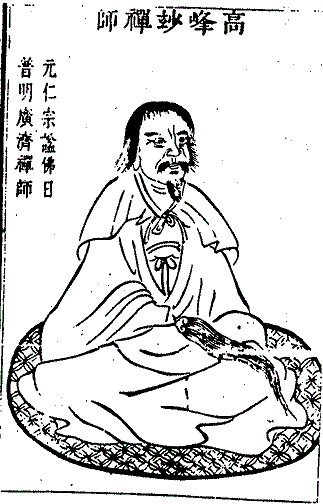ZEN MESTEREK ZEN MASTERS
« Zen főoldal
« vissza a Terebess Online nyitólapjára

高峰原妙 Gaofeng Yuanmiao (1238-1295)
(Rōmaji:) Kōhō Genmyō

高峰原玅 Gaofeng Yuanmiao
Gaofeng Yuanmiao. (J. Kōhō Genmyō; K. Kobong Wŏnmyo 高峰原妙) (1238–
1295). Yuan-dynasty Chinese CHAN monk in the YANGQI PAI of the LINJI
ZONG. Gaofeng was a native of Suzhou in present-day Jiangsu province. He was
ordained at the age of fourteen and two years later began his studies of
TIANTAI thought and practice under Fazhu (d.u.) at the monastery of Miyinsi. He later
continued his studies under Chan master WUZHUN SHIFAN’s disciples
Duanqiao Miaolun (1201–1261) and Xueyan Zuqin (1215–1287). Gaofeng
trained in Chan questioning meditation (看話禪 KANHUA CHAN), and Xueyan Zuqin
taught him the necessity of contemplating his meditative topic (HUATOU) not
just while awake, but also during dreams, and even in dreamless sleep. (In his
own instructions on GONG’AN practice, Gaofeng eventually used the same
question Zuqin had asked him: “Do you have mastery of yourself even in
dreamless sleep?”) In 1266, Gaofeng went into retreat at Longxu in the Tianmu
mountains of Linan (in present-day Zhejiang province) for five years, of
which he is said to have had a great awakening when the sound of a falling pillow
shattered his doubt (YIQING). In 1274, he began his residence at a hermitage on
Shuangji peak in Wukang (present-day Zhejiang province), and in 1279 he began
teaching at Shiziyan on the west peak of the Tianmu mountains. He subsequently
established the monasteries of Shizisi and Dajuesi, where he attracted hundreds of
disciples, including the prominent ZHONGFENG MINGBEN (1263–1323). He
was given the posthumous title Chan Master Puming Guangji (Universal
Radiance and Far-reaching Salvation). Gaofeng is most renowned for his
instruction on the “three essentials” (SANYAO) of kanhua Chan practice: the
great faculty of faith, great fury, and great doubt. Gaofeng’s teachings are
recorded in his discourse record, the Gaofeng dashi yulu, and his GAOFENG
HESHANG CHANYAO*, better known as simply the Chanyao (“Essentials of
Chan”; K. Sŏnyo), which has been a principal text in Korean monastic seminaries
since at least the seventeenth century. Gaofeng is also known for his famous
gong’an: “Harnessing the moon, the muddy ox enters the sea.”
*Gaofeng heshang Chanyao. (J. Kōhō oshō Zen’yō/Kōbō oshō Zen’yō; K. Kobong
hwasang Sŏnyo 高峰和尚禪要). In Chinese, “Master Gaofeng’s Essentials of
CHAN,” often known by its abbreviated title Chanyao (J. Zenyō; K. Sŏnyo),
“Essentials of Chan.” The text is best known for its exposition of the “three
essentials” (SANYAO) of Chan questioning meditation (KANHUA CHAN): the
great faculty of faith, great fury, and great doubt (YIQING). The text was
republished in Korea in 1399, where it became widely read as a primer on the
practice of GONG’AN meditation. Since the seventeenth century, Korean
Buddhist seminaries (kangwŏn) have included the Chanyao/Sŏnyo as one of the
four books in the SAJIP (Fourfold Collection), the core of the Korean monastic
curriculum.
The Princeton Dictionary of Buddhism (2014)
高峰原妙禪師禪要 Gaofeng yuanmiao chanshi chanyao (Essentials of Chan)
高峰原妙禪師語錄 Gaofeng yuanmiao chanshi yulu (Records of Chan Master Gaofeng Yuanmiao)
PDF: The Transformation of Doubt (Ŭijŏng 疑情) in Kanhwa Sŏn 看話禪: The Testimony of Gaofeng Yuanmiao 高峰原妙 (1238-1295).
by
Prof. Robert E. Buswell , Jr.
Halves and Holes: Collections, Networks, and Epistolary Practices of Chan Monks
by Natasha HELLER
in:
Antje Richter, ed., A History of Chinese Letters and Epistolary Culture (Handbook of Oriental Studies 4.31) Brill: Leiden, 2015.
The letters of three generations of Chan masters--Gaofeng Yuanmiao 高峰原 妙 (1238-1295), Zhongfeng Mingben 中峰明 本 (1263-1363), and Tianru Weize 天如惟 則 (d. 1354)--provide a window into the epistolary practices of Buddhist monks and the collecting decisions of their disciples. Monks and their disciples wrote letters to reflect on their own spiritual progress and internal state. In response to queries by students, monks also wrote letters to explain Chan teachings. Not all letters were doctrinal in nature: many letters had administrative functions, helping to fundraise or otherwise facilitating the affairs of the monastery. Like letters in the secular realm, monks also wrote letters to affirm social ties and to accompany gifts. For these Chan monks, the social and ritual function of epistolary exchange meant that letters did not represent "entanglements" in the same way that other literary endeavors did.
|
|
|
禪關策進 Changuan cejin [Progress in the Path of Chan]
by 云栖祩宏 Yunqi Zhuhong (1535–1615)
PDF: The Chan whip anthology : a companion to Zen practice
Translated by Jeffrey L. Broughton with Elise Yoko Watanabe
New York : Oxford University Press, 2014.Chan Master Gaofeng Yuan[miao] of [Mt.] Tianmu Instructs the Sangha
pp. 91-96.